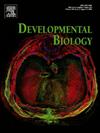Naturally occurring, rostrally conjoining chicken twins attempt to make a forebrain
IF 2.5
3区 生物学
Q2 DEVELOPMENTAL BIOLOGY
引用次数: 0
Abstract
Conjoined twinning is a special case of monozygotic, monoamniotic twinning. Human conjoined twinning, and vertebrate conjoined twinning in general, is a very rare phenomenon. It has been suggested that the risk of conjoined twinning increases with some medication and upon assisted reproduction. Survival rates are low.
When conjoined twins occur in the chicken, they most often present with fused heads, anatomically unrecognisable brains and two normal bodies. Recent studies suggested that forebrain, midbrain and rostral hindbrain identities are established in the early epiblast before neural induction and independent from caudal hindbrain and spinal cord identities. Therefore, it is unclear whether in conjoined twins, the aberrant brain anatomy is a result of the rostral fusion, or whether the brains failed to develop in the first place.
Here, we collected conjoined twins as they spontaneously appeared in eggs incubated for stages HH4 (late primitive steak stage) to HH13 (early pharyngula). The twinned embryos and stage-matched normal embryos were analysed for the expression of the rostral epiblast and forebrain-midbrain marker Otx2 and the ventral forebrain marker Six3. We found normal anatomy and marker gene expression that lasted up to stage HH9. By HH12-13, the brain anatomy had deteriorated, but marker genes remained expressed. This suggests that the fusing embryos attempted to generate a brain including the forebrain.
Besides addressing forebrain development, our work for the first time provides a time frame to study the mechanisms underlying the interaction and fusion of conjoined twins, which will pave the way to a better understanding and management of risk factors in humans.
自然发生的,雌性连体鸡双胞胎试图制造一个前脑。
连体双胞胎是单卵、单羊膜双胞胎的一种特殊情况。人类的连体双胞胎,以及脊椎动物的连体双胞胎,是一种非常罕见的现象。有人认为,一些药物和辅助生殖会增加连体双胞胎的风险。存活率很低。当鸡中出现连体双胞胎时,他们通常会出现融合的头部,解剖学上无法识别的大脑和两个正常的身体。最近的研究表明,前脑、中脑和吻侧后脑的身份是在神经诱导之前的早期外胚层建立的,独立于尾侧后脑和脊髓的身份。因此,目前尚不清楚,在连体双胞胎中,异常的大脑解剖结构是吻侧融合的结果,还是大脑一开始就没有发育。在这里,我们收集了在HH4期(原始牛排期晚期)到HH13期(早期咽期)孵化的卵子中自发出现的连体双胞胎。对双胞胎胚胎和分期匹配的正常胚胎进行吻侧外胚层和前脑-中脑标记Otx2和腹侧前脑标记Six3的表达分析。我们发现正常的解剖结构和标记基因表达持续到HH9期。到HH12-13时,脑解剖结构已经恶化,但标记基因仍然表达。这表明融合胚胎试图产生包括前脑在内的大脑。除了解决前脑发育问题外,我们的工作首次为研究连体双胞胎相互作用和融合的机制提供了一个时间框架,这将为更好地理解和管理人类的风险因素铺平道路。
本文章由计算机程序翻译,如有差异,请以英文原文为准。
求助全文
约1分钟内获得全文
求助全文
来源期刊

Developmental biology
生物-发育生物学
CiteScore
5.30
自引率
3.70%
发文量
182
审稿时长
1.5 months
期刊介绍:
Developmental Biology (DB) publishes original research on mechanisms of development, differentiation, and growth in animals and plants at the molecular, cellular, genetic and evolutionary levels. Areas of particular emphasis include transcriptional control mechanisms, embryonic patterning, cell-cell interactions, growth factors and signal transduction, and regulatory hierarchies in developing plants and animals.
 求助内容:
求助内容: 应助结果提醒方式:
应助结果提醒方式:


